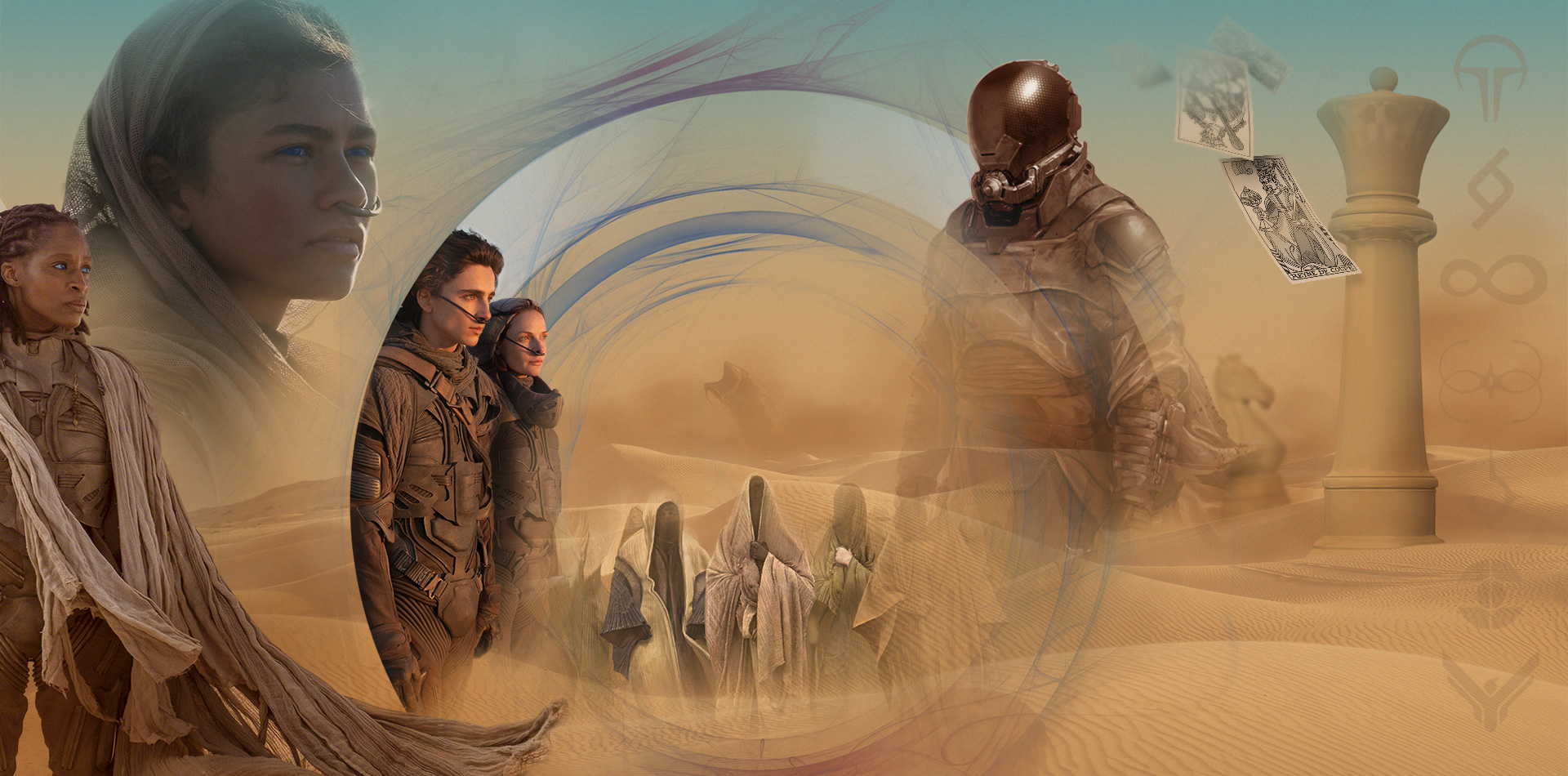By Gary Foss | December 9, 2021
Dune: Past, Present & Future
Jacqueline West & Robert Morgan
Since it was published in 1965, Frank Herbert’s Dune has been described as an epic, an instant science fiction classic, and alarmingly, “unfilmable.” Herbert created a complex, galaxy-spanning socio-political system with an elaborate theological life, thousands of years of history, and entire worlds of cultural development which frame an adventure story populated with fully realized, deep characters.
The notoriously challenging project has been attempted several times, but it has remained the “third rail” of science fiction adaptations. The story drops us into a formed historical period already in progress. Dune is a project in which the costumes transcend character and become part of the world building. It is both intricate and overt. We spoke with costume designers Jacqueline West and Robert Morgan about their work to bring one of science fiction’s greatest stories to life.



Foss: I think first we’ve got to talk about the stillsuits. That’s such an important costume. It’s a uniform, but each is bespoke. If the stillsuits don’t work, then the movie doesn’t work. There’s even a scene where the characters just talk about what they’re wearing. It’s one of those great moments that breaks the fourth wall of costumes, so to speak.
West: Yes, it was the centerpiece for both Herbert and our director Denis Villaneuve. It’s the first thing we attacked. The stillsuit is a distillery system. You’re not supposed to lose any body moisture. It’s converted into potable drinking water or cooling water. It’s all run by a pumping system powered by the movement of your body, from your heels up your whole musculature to your lungs, so it had to be really form-fitting on all these different bodies to sell it as a mechanically run distillery. It had to fit petite Lady Jessica (Rebecca Ferguson) all the way to Duncan Idaho (Jason Momoa). Frank Herbert describes it rather intricately. We both have worked with Keith Christensen, our amazing concept artist, who was obsessed with the book. He came up with a drawing that we put in front of Denis and he deeply loved it. Jose Fernandez, at Ironhead, is a brilliant sculptor. He came up with the first prototype. We had textile artists make different layers of fabric. Because we knew that our actors would be wearing these in the desert, in Jordan, in extreme heat, we made a micro sandwich of fabrics, not unlike the fabrics that wick moisture away under football padding. Then we made acrylic layers and netting and mesh.
Morgan: We realized that the stillsuit had to be right. We were tweaking it right up until the moment we shot. We didn’t want to lose the individuality in those costumes. You have so many people wearing it. One of our artisans made talismans, odd little metal things, some had beads. We let the actors pick what sparked their fancy. They were little Easter eggs. We’d tie little things to them, or around the legs, or woven into the arm pieces. I think of how Vietnam soldiers used to do. If you’re living in the desert for your whole life, that stillsuit is a uniform, but I liked that personalization.
Foss: This project is a little unusual in that you guys have co-costume designer credits. How did
that come about and what was the division of labor between you?
West: Bob had so much experience doing specialty costumes. I do a lot of period films, and felt that he would be a real asset on this film because there were over 400 builds. I was the main designer and I worked with Keith Christensen, and Bob hired the most amazing crew which he gleaned from all over Europe. We divided up the labor that way.
Morgan: We really just share the film. When Jacqueline asked me to join her, it was so large and in a distant place, where you didn’t have resources or vendors that you normally would rely on. We started in Los Angeles, but I looked at Jacqueline and said, “I’ve got to go to Budapest.” So off I went and she stayed in LA and worked with Jose Fernandez, working out the stillsuit. We’d have Zoom fittings and Zoom meetings. It became apparent that we were not going to be able to make everything in Budapest. I think at some point, we had over 200 people these amazing artisans. We made a lot there but we needed to go to the UK and FB Effects. I’d worked with them before and love their work. She would watch what was happening in Budapest while I was in the UK. We did a lot of leapfrog. Then I went to Jordan and established those costumes. Looking back now, I really can’t imagine how you would do all that with one costume designer.
Foss: What was the process for Paul (Timothée Chalamet)?
Morgan: Timothée has an amazing, romantic Valentino thing. He wears clothing so well, and he loves new and classic designers. We set up the fitting room with fans and fabric blowing because we knew these costumes were constantly in the wind or in the sand. He came to the stillsuit and made it look good, sharp, and elegant. The first fitting he got down on all fours and was crawling like a spider and doing that sandwalk.
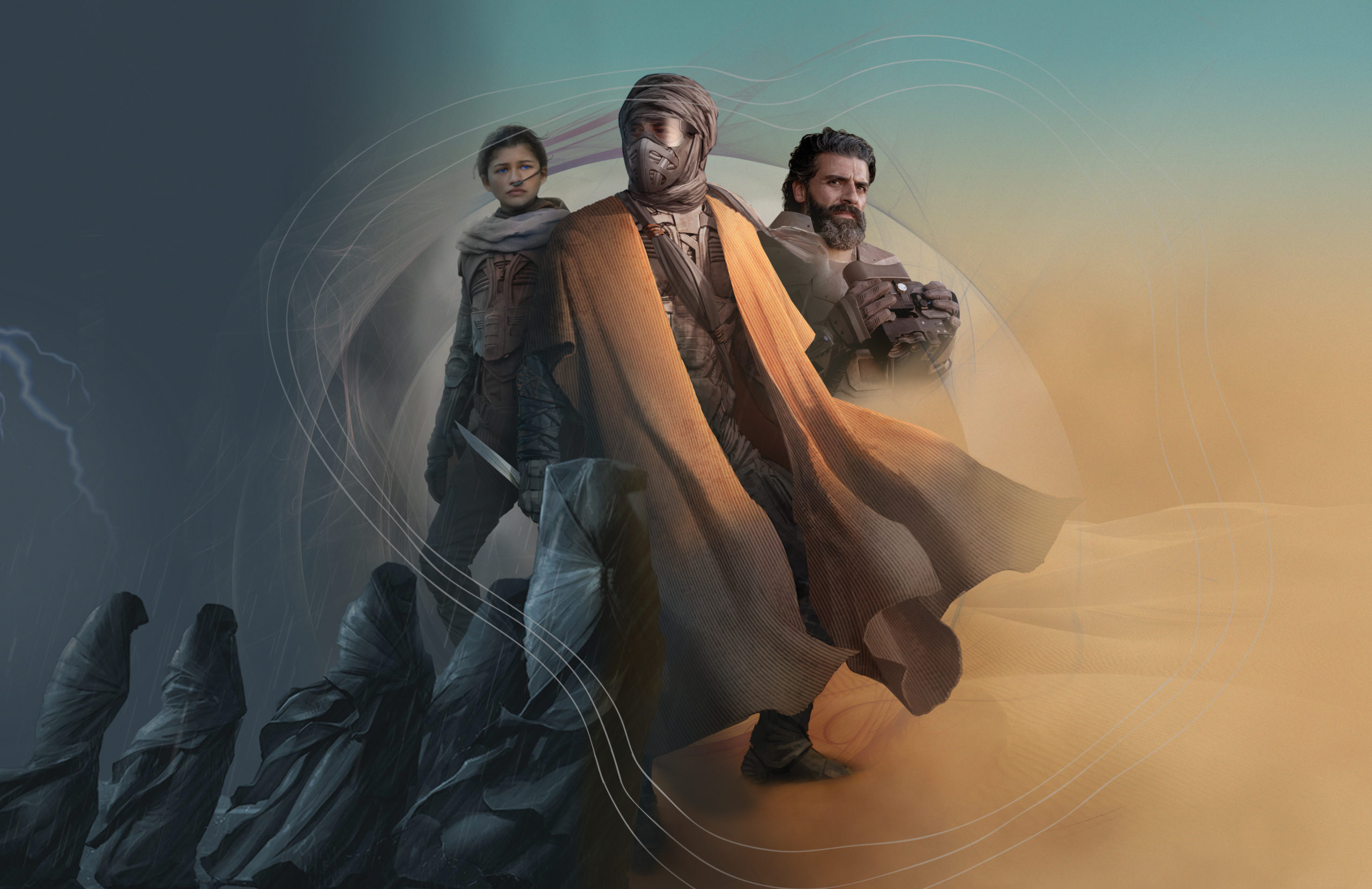
West: I’ve always been intrigued by David Lean, and I always felt that Paul was Zhivago meets Lawrence of Arabia. For Paul you’ll see the Zhivago shirts. I told everyone that buttons and zippers did not make it into the future. The Zhivago shirt closes with rare earth magnets. You just touch it and it clicks closed right from the bottom up. Denis loved it so much, he had me make him one. I also made one for Duncan Idaho. Everybody had them on underneath their beautiful, deep green, Caladan uniforms.
Foss: Lady Jessica (Rebecca Ferguson) is such a complex character.
West: When Lady Jessica lands on Arrakis, she has to be magnificent, but still look like some kind of “modieval” courtesan in a latticed, almost snood-like headpiece. I decided it should be over her face to give her mystery. We made it in gold chain. It drapes over Rebecca Ferguson’s face all the way down her chest. Bob hired this lovely British woman, Bryony Tyrrell, to do some specialty costumes for us. She worked on that the whole movie and it shot late in the schedule. Bob called it the most expensive costume ever made.
Morgan: Jessica is not a queen, but she’s one of the most powerful people in the story. Rebecca is so elegant. When we looked at her, we saw this very powerful, adaptable woman. We let her transition when she arrives on Arrakis in that spice colored dress with the veil and the chains on her face. She was embodying the most beautiful part of that world with that veil. Everybody’s dressed in sand colored gauze and wraps, very muted color. Suddenly you have this family coming out and there’s the Duke’s lady. That image with a veil blowing in the wind and sparkling on the chains. The intent was that she parted the waters—or parted the sand, I guess, in this case.
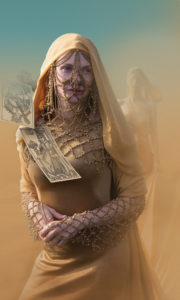
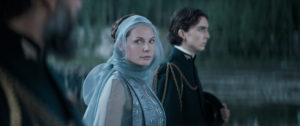
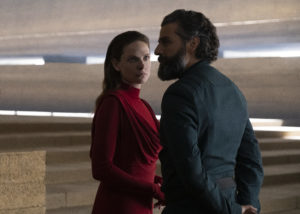
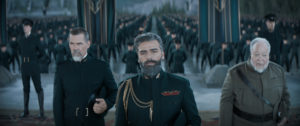
Foss: What about the other characters? Some we get just for a scene or two, but they’re all so distinct. What was the inspiration for the Mother Gaius Helen Mohiam (Charlotte Rampling)?
West: I was an art historian and I relied a lot on the past to create this future. For the Bene Gesserit, I went to tarot cards. I’ve always loved tarot and have many sets. For Mother Mohiam specifically, I used the queen of the wands, queen of cups, the high priestess along with medieval chess pieces of the queen. It’s a world starting over back to the past. I call it “modieval.” Caladin is a green planet. It’s the reason it’s so sad for them to lose it because of the dictates of the Imperium. I went to paintings of the Romanovs for that costume, and it was kind of the Romanovs meets Fahrenheit 451.
Foss: There’s a real shift when we get to Arrakis, where it’s a struggle to survive. How did that influence your designs?
Morgan: For Arrakis, you think of the desert and the Tuareg people of Morocco. At least, I did when I read the book. The Bedouin women with the wraps. It is very beautiful. Yet they’re survivors, so that’s reflected in their clothes. Those head wraps are tools. They’re not just decoration. That color, the weight, the length. It unwinds as 25 yards of fabric. It’s a rope, it’s a hammock, it’s a tent, it’s a screen. It’s whatever you need it to be to protect against the sun and the sand. That was based in art and in the real world.
West: All of their wrappings were gauze. They didn’t use goggles. They protected their faces from the sun with gauze wrappings. The location manager brought us vials of all the different rock and sand colors from Jordan. We matched the gauze to those colors, because I wanted them to be camouflaged. The stillsuit we matched to the dark rocks. As they’re crossing the desert, we wrapped it in gauzes that also shift as Bob mentioned. Like the Tuareg, they shift with the sands. You get that romantic feeling of movement. We also made turbans and face wraps. You see their faces in the dramatic scenes but they could be pulled up on their heads when they have to protect themselves from the wind and sand.
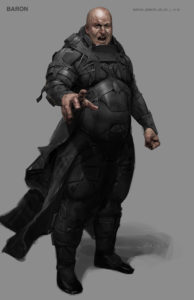
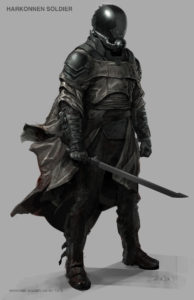
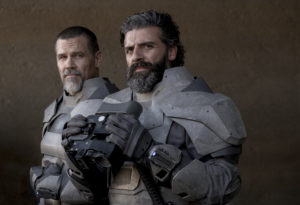
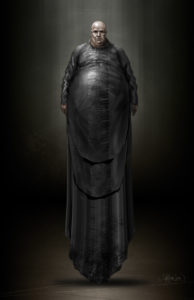
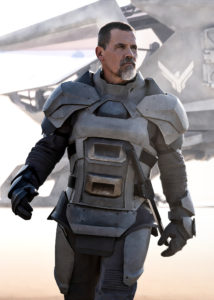
Foss: Let’s talk about the Harkonnen, the main antagonists.
Morgan: The Harkonnen are bad-ass. I think of H.R. Giger. Everything was kind of dark and spidery and bony and like bug parts, even the helmets. We looked at insect heads. At a moment’s notice, you know if you’re looking at the Harkonnens, the Atreides, or the Arrakeens. There’s no confusion. Sometimes you get just a visual second on screen to see who the good or the bad guys are when they’re having these battles.
West: I love Piter de Vries (David Dastmalchian). I always think that dark and evil is always the hardest thing to costume without being overarching. He’s like a stiletto. I compared him to a praying mantis. That long, pencil-like black figure. The back of the costume is all laced with this line like a reptile running down his back. There’s something about the silhouette that I just loved. I’d looked for the fabric for years. It’s a shiny, black taffeta coated in some kind of acrylic finish. It looks like oil cloth, but less organic. I just love how he wears it—with such aplomb.
Foss: There are a lot of bold, smart choices in this film, and a lot of them are directorial. What was it like working with Denis Villeneuve?
West: He’s incredibly collaborative and doesn’t micromanage. He lets you come up with it. When you show him, you know you’ve got it because he has such visceral reaction. He has this line—until you get that line, you keep going. He’d say, “I deeply love it. I deeply love it, Jacqueline.”
Morgan: Denis is the most amazing person you could ever work with. As was the assemblage of artisans, creatives, and actors across the board. This was one of those experiences that you’ll remember for a lifetime. It’s a subject matter that so many of us love and then to have a director like Denis. It was just really wonderful.
Foss: Jacqueline, weren’t you living near where Frank Herbert wrote the book?
West: Yes, when I was quite young living in Berkeley, I lived on a houseboat in Sausalito at Kappas number six, which became quite an iconic place in the Bay Area. Alan Watts’ houseboat was right across the way. Years later, a friend of mine who was writing at the Chronicle told me that Frank Herbert would go to Alan Watts’ ferry and work on Dune. His houseboat was about 30 feet from the bow of my houseboat, and all that time I didn’t even know that.
Foss: So it was destiny.
West: It was.
Foss: Well, the whole movie looks amazing. I’ve been a fan of the book for over 40 years. I’m sure I’m not alone in that, but I was so pleased. I have to tell you, at the screening, a colleague asked me what I thought when the credits started to roll, and I said, “It’s a triumph.”
Morgan: That means the world to me. I hope that everyone goes to see this on a big screen and the new devotees enjoy it just as much as you and I do.
West: I call it the Dune everyone’s been waiting to get made.
View this article in the latest issue of The Costume Designer.


